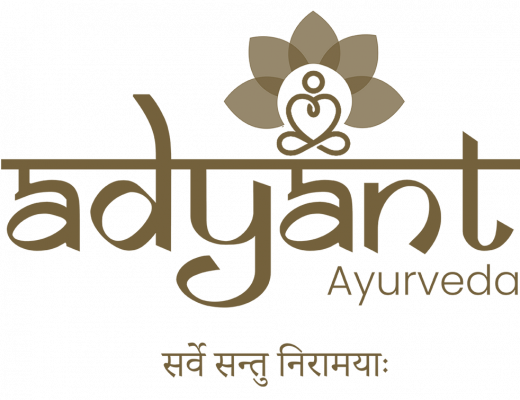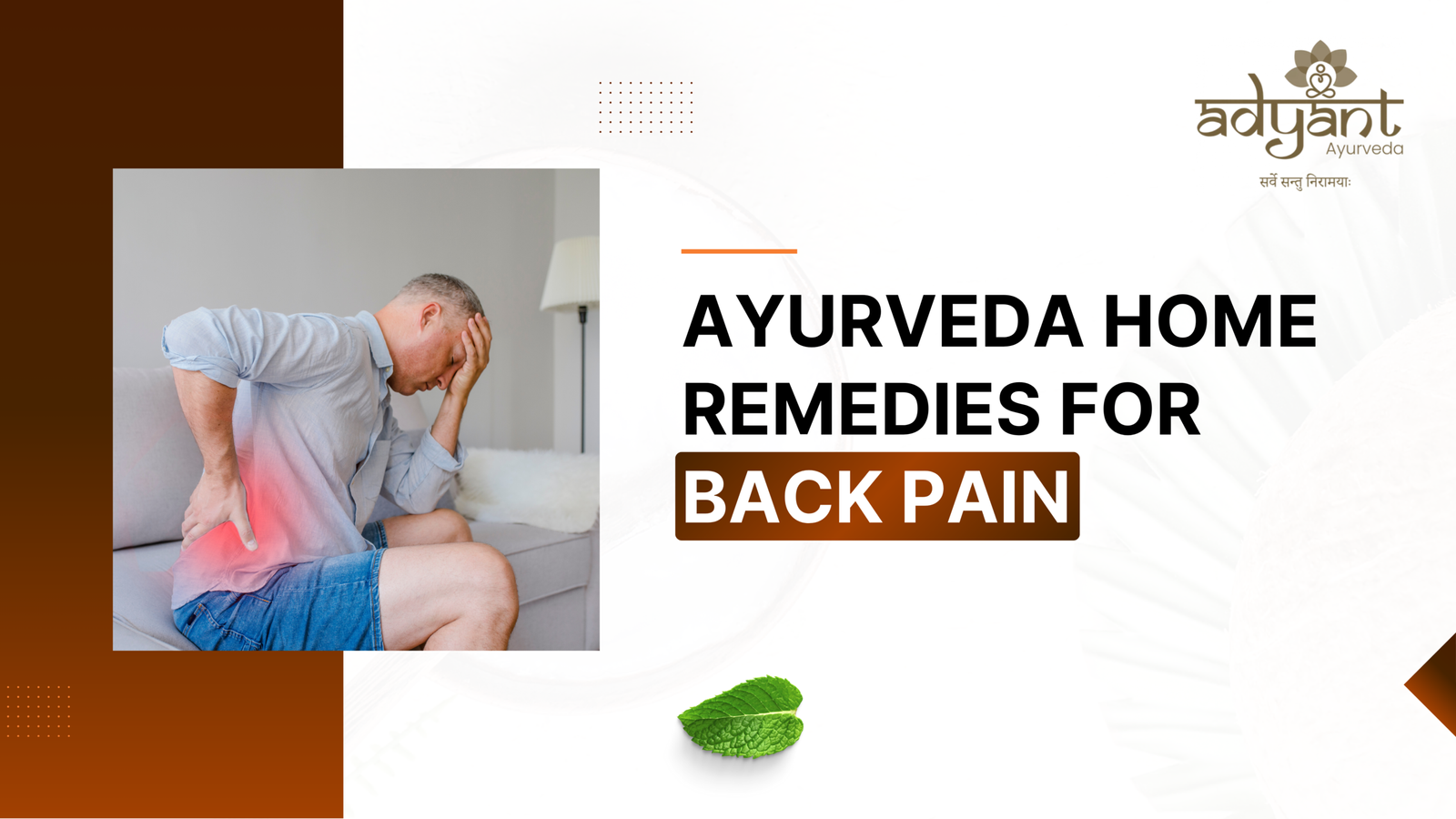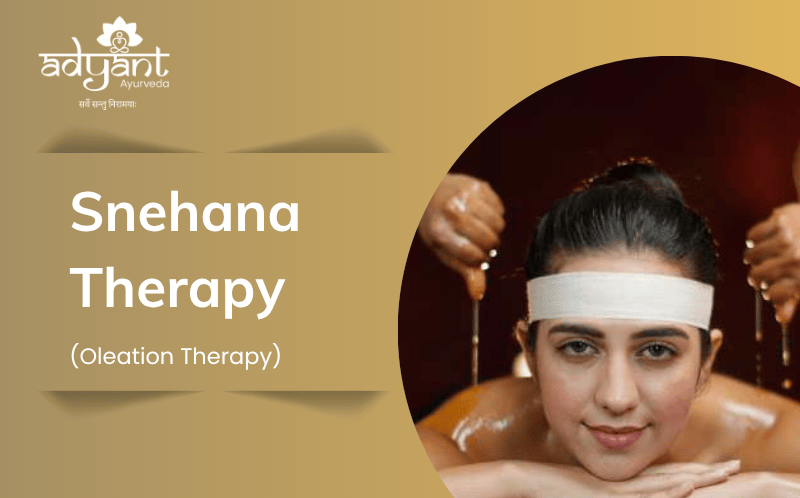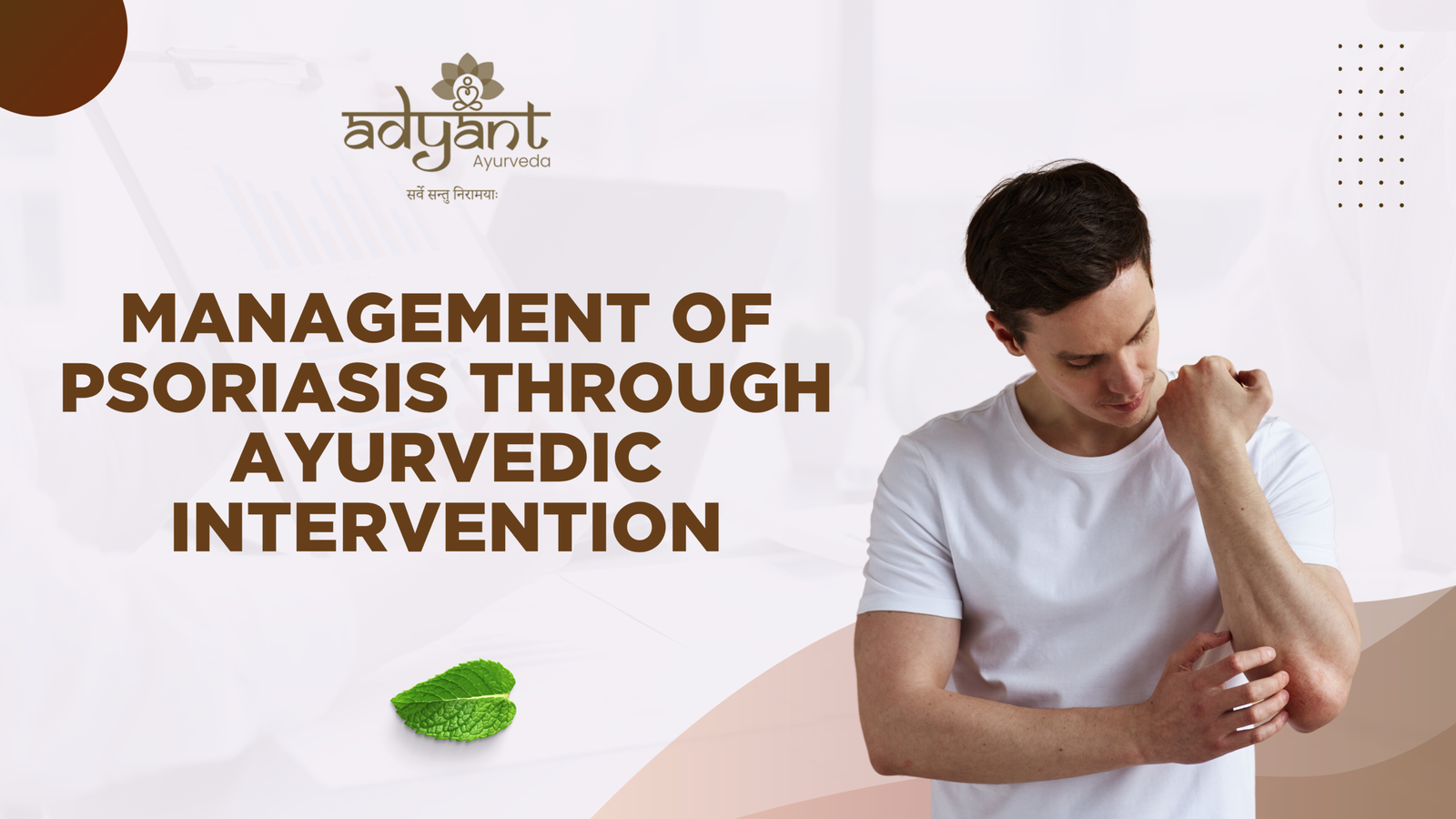Table of Contents
ToggleAuthor: Dr. Sumana Patvardhana, BAMS, MD (Ayurveda) – Senior Ayurvedic Skin Specialist, Indiranagar Branch, Adyant Ayurveda
Introduction to Skin allergies
Skin allergies affect millions globally, causing itching, redness, rashes, swelling, and dryness. While modern medicine often relies on antihistamines and steroids, Ayurveda provides a root-cause approach that focuses on balancing doshas, clearing ama (toxins), and strengthening skin immunity.
📖 Ayurvedic Reference:
“Raktaṃ pittānubandhaṃ tu, tṛṣṇā daha kṣudhātṛṣaḥ |
Tvakrogaḥ krimi visarpaḥ, śophāḥ kuṣṭhāni jāyate ||”
Meaning: Impurities in blood (Rakta) associated with aggravated Pitta dosha lead to skin disorders such as allergies, rashes, swelling, and eczema.
This guide covers: Ayurvedic understanding, types, causes, diagnosis, treatment, herbs, home care, prevention, recovery, cost of care, and expert opinions.
Ayurveda’s View of Skin Allergy (Kushta Roga / Tvak Vikara)
According to Ayurveda, skin allergies arise from dosha imbalance, with Pitta–Rakta dushti often dominant.
Pitta ↑ → redness, burning, inflammation
Vata ↑ → dryness, scaling, intense itching
Kapha ↑ → oozing, swelling, thickened skin
📖 Charaka Samhita:
“Kushtāni bahu rūpāṇi duṣya-prabhavato bhavet”
(Skin diseases manifest when doshas and tissues are vitiated.)
When digestion weakens (Mandagni), undigested residues (Ama) circulate and lodge in skin (Tvak) and blood (Rakta), triggering hypersensitivity.
🌿 Expert Note – Dr. Apoorva, Ayurvedic Dermatologist
“Skin allergies are not superficial problems but indicators of deeper imbalances in digestion, immunity, and blood quality. Panchakarma therapies like Virechana, Vamana, and Raktamokshana, along with classical medicines, provide long-term relief without dependency on steroids or antihistamines.”
✨ – Dr. Apoorva, Senior Ayurvedic Dermatologist at Adyant Ayurveda, Bangalore
Types of Skin Allergies (Modern ↔ Ayurvedic Lens)
Eczema / Atopic Dermatitis (Pitta–Vata): dry, itchy plaques; impaired barrier
Urticaria (Pitta): transient wheals, itching; often food/stress triggered
Contact Dermatitis (Kapha–Pitta): metals, detergents, dyes
Seborrheic / Fungal Flare-ups (Kapha): oily, scaly, dandruff-like
Psoriasis (Vata–Kapha with Pitta flares): chronic, often mistaken for an allergy
Causes & Triggers
- Diet: Viruddha āhāra (milk + fish, curd at night), spicy/oily foods, alcohol, sugar
- Lifestyle: stress, sleep deprivation, synthetic clothing, harsh soaps
- Environment: heat/sun (Pitta), humidity/mold (Kapha), cold/dry winds (Vata)
- Contact: nickel, dyes, latex, detergents
- Internal: weak Agni, gut dysbiosis, hormonal changes, genetics
Red Flags – Seek Urgent Care if:
- Rapidly spreading rash with fever
- Facial/tongue swelling, difficulty breathing (possible anaphylaxis)
- Painful blistering, pus, oozing
- Severe dehydration (esp. children, elderly)
- Rash after new medication/vaccine
Ayurvedic Diagnosis
Modern tests: clinical exam, patch test, IgE, CBC, LFTs
Ayurveda:
Ashtavidha Pariksha (pulse, urine, stool, tongue, etc.)
Dashavidha Pariksha (prakriti, agni, bala, satmya, etc.)
Doshic dominance + Dhatu involvement (Rakta/Mamsa)
Severity can also be tracked with SCORAD (eczema) or UAS7 (urticaria).
Step-Wise Ayurvedic Treatment Plan (Adyant Ayurveda)
A) By Severity
Mild (localized, no oozing): Haridra, Neem, Guduchi, Manjistha; Khadirarishta; Neem–Tulsi–Aloe paste; coconut oil
Moderate (widespread/recurrent): Virechana, Basti, Raktamokshana; Haridra Khanda, Arogyavardhini Vati, Gandhak Rasayan; Shirodhara
Severe/Chronic: structured Panchakarma detox; Rasayana herbs; integrative care with allopathy
⚠️ Avoid strong Panchakarma in pregnancy, severe anemia, and infections.
B) By Doshic Pattern (Quick Guide)
Pitta dominant: Guduchi, Amalaki, Sariva, Usheera; Virechana; aloe/sandal wash
Vata dominant: Ghee-based Rasayana, Dashamoola, Basti; coconut/Kumkumadi oil
Kapha dominant: Trikatu, Khadira, Neem; mild Udvartana; Khadirarishta
Best Ayurvedic Treatment for Skin Allergy
Panchakarma is one of the most effective Ayurvedic approaches for managing skin allergies, as it cleanses toxins (ama) from the body and purifies the blood (Rakta shodhana). Depending on the dosha imbalance, different Panchakarma therapies are chosen:
Virechana (Therapeutic Purgation): Removes excess Pitta and Rakta dushti, relieving redness, burning, and rashes.
Raktamokshana (Bloodletting): Clears impure blood and reduces chronic itching, hives, and eczema.
Basti (Medicated Enema): Corrects Vata imbalance, dryness, and scaling.
Vamana (Therapeutic Emesis): Helps expel excess Kapha and allergens from the system, useful in chronic urticaria and oozing skin allergies.
Abhyanga & Takradhara: Nourish the skin, soothe inflammation, and calm stress-related flare-ups.
By cleansing the system from within, Panchakarma not only provides long-term relief from itching and irritation but also improves skin immunity and prevents recurrence.
Ayurvedic Herbs for Skin Allergy
| Herb | Sanskrit Name | Key Properties | Benefits |
|---|---|---|---|
| Neem | Nimba | Bitter, cooling | Purifies blood, reduces itching |
| Manjistha | Manjistha | Astringent, detoxifier | Removes toxins, balances Pitta |
| Turmeric | Haridra | Anti-inflammatory | Anti-allergic, boosts immunity |
| Aloe Vera | Kumari | Cooling, soothing | Hydrates, reduces burning |
| Khadira | Khadira | Astringent | Effective in eczema, rashes |
| Sariva | Sariva | Cooling | Relieves burning & itching |
📖 Bhavaprakasha Nighantu:
“Raktapitta-kushta-Visarpa-Kandvijvarapaha |
Sarvarogahara Nityam Nimba Paatram Vidhiyate ||”
(Neem leaves are effective in skin disorders, itching, and blood impurities.)
Classical Ayurvedic Formulations
| Formulation | Main Ingredients | Usage |
|---|---|---|
| Mahamanjistadi Kwath | Manjistha, Haridra, Triphala | Blood purifier decoction |
| Khadirarishta | Khadira, Devadaru, Triphala | Manages itching & eczema |
| Panchatikta Ghrita Guggulu | Neem, Patola, Guduchi | Chronic skin disorders |
| Arogyavardhini Vati | Kutki, Triphala, Shilajit | Detoxifies liver & skin |
| Nimbadi Kwath | Neem, Guduchi, Patola | Relieves Pitta & rashes |
(Dosage under medical supervision only.)
Safe Home Remedies
Neem water bath
Aloe vera gel (pure)
Turmeric + honey paste (small patches)
Oatmeal compress
Coconut/jojoba oils as emollients
Diet & Lifestyle (Pathya–Apathya)
✅ Include: barley, moong dal, gourds, leafy greens, pomegranate, cumin–fennel water
❌ Avoid: fried/spicy foods, dairy excess, fermented foods, alcohol, sugar
Regular sleep, cotton clothing
Stress relief (meditation, pranayama)
Daily Abhyanga (oil massage)
Seasonal care: Kapha → detox; Pitta → cooling foods; Vata → warm oils
Case Snapshots
Chronic Urticaria (F, 32): 5 yrs hives → Haridra Khanda + Virechana → 80% relief in 8 weeks
Atopic Dermatitis (M, 11): Winter flares → Bala Taila + Mahamanjishtadi Kwath → flare-free 6 months
Cost of Ayurvedic Skin Allergy Treatment
Consultation: ₹400 – ₹500
Panchakarma session: ₹12,000 – ₹15,000
Medicines/month: ₹2,000 – ₹2,500/
Why Choose Adyant Ayurveda?
28+ years in Ayurvedic dermatology
Team: Dr. Sumana, Dr. Apoorva, Dr. Shree Lakshmi, Dr. Vidya, Dr. Preethi
5 centers in Bangalore
Gentle, integrative care with personalized protocols
Digital care via AyurCare app (consults, e-prescriptions, follow-ups)
📞 Call/WhatsApp: +91-9972541009 | 🌐 www.adyantayurveda.com | 📲 Download the AyurCare app
Frequently Asked Questions (FAQs) on Ayurvedic Treatment for Skin Allergy
What are skin allergies according to Ayurveda?
In Ayurveda, skin allergies are often classified under Kushta Roga and result from an imbalance of the three doshas, mainly Pitta and Kapha. Accumulation of ama (toxins) in the blood and skin leads to itching, redness, and inflammation.
Can Ayurveda permanently cure skin allergies?
Ayurveda aims at treating the root cause rather than just symptoms. By balancing doshas, detoxifying the body (through Panchakarma like Virechana and Raktamokshana), and strengthening immunity, Ayurveda helps in long-term management and may prevent recurrence.
How safe are Ayurvedic treatments for skin allergies?
Yes, Ayurvedic treatments are generally safe when prescribed by qualified doctors. They use natural herbs, oils, and therapies, avoiding harsh chemicals or steroids. However, self-medication is not recommended—always consult an Ayurvedic skin specialist.
Which Ayurvedic herbs are effective for skin allergies?
Some commonly prescribed herbs include:
- Neem (Azadirachta indica) – blood purifier
- Haridra (Turmeric) – anti-inflammatory and anti-allergic
- Manjistha – improves skin complexion and detoxifies blood
- Guduchi (Giloy) – enhances immunity
What Panchakarma therapies are useful for skin allergy?
Virechana (therapeutic purgation) – to eliminate excess Pitta
Raktamokshana (bloodletting) – for blood purification
Abhyanga & Takradhara – to soothe itching and inflammation
What diet should I follow during Ayurvedic treatment for skin allergy?
Avoid: Spicy, oily, fermented foods, seafood, and excess sugar.
Include: Fresh fruits, green leafy vegetables, whole grains, herbal teas, and bitter-tasting foods like neem and karela.
Can Ayurveda help in eczema, urticaria, or contact dermatitis?
Yes, Ayurveda provides personalized treatment for various forms of skin allergies. The treatment plan differs depending on dosha involvement, severity, and chronicity. For example, eczema is managed with cooling herbs, medicated ghee, and detox therapies.
How long does Ayurvedic treatment for skin allergy take?
Treatment duration varies depending on the severity and chronic nature of the allergy. Acute cases may respond within a few weeks, while chronic allergies may require 2–3 months of consistent treatment, including diet and lifestyle modifications.
Can I combine Ayurvedic treatment with modern medicine for skin allergy?
Yes, Ayurveda can be integrated with modern medicine under expert supervision. For patients already on antihistamines or steroid creams, Ayurvedic doctors gradually transition them to natural remedies while ensuring safety.
Is Ayurvedic treatment suitable for children with skin allergies?
Yes, Ayurveda offers safe herbal remedies, external applications, and dietary guidance for children. However, Panchakarma is usually avoided below 12 years, and treatment focuses on gentle detox and immunity-boosting herbs under medical supervision.
Conclusion: Ayurvedic Treatment for Skin Allergy
Skin allergies can disrupt daily life and become chronic if untreated. Ayurveda offers a holistic, root-cause approach through dosha balancing, detoxification, and immune strengthening. At Adyant Ayurveda, our dermatology team combines classical Ayurveda + modern insights to deliver safe, effective, and lasting results.
✍️ Author: Dr. Sumana Patvardhana, BAMS, MD (Ayurveda) – 24 yrs experience
✅ Reviewed by: Dr. Shree Lakshmi, Senior Ayurvedic Physician
🌿 Expert Comment: Dr. Apoorva, Ayurvedic Dermatologist
⚠️ Disclaimer: This article is for educational purposes only, not a substitute for professional advice. Always consult a qualified Ayurvedic doctor.








